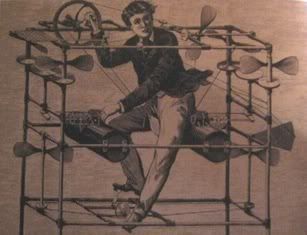
With lighter-than-air balloons becoming an increasingly familiar sight in the skies over Europe during the nineteenth century, aviation gained acceptance as a scientific pursuit.
What had once been viewed as an inane attempt to overcome the laws of physics and gravity was now seen as a training ground for many bright and talented engineers and inventors.
Further advancing the understanding of aerodynamics, Sir George Cayley attached a pilot-operated rudder to his mid-nineteenth century glider.
'It was beautiful,' he wrote concerning this, 'to see this noble white bird sailing majestically from the top of a hill to any given point of the plain below it with perfect steadiness and safety, according to the set of its rudder, merely by its own weight, descending at an angle of about eight degrees with the horizon.'
 True to the teachings of Sir George Cayley, William Samuel Henson designed his Aerial Steam Carriage with an extended wing-span in order to maximize lift.
True to the teachings of Sir George Cayley, William Samuel Henson designed his Aerial Steam Carriage with an extended wing-span in order to maximize lift. While gaining in stature among the scientific community, aviation was still the dream of choice for inventors such as W. O. Ayres and his "Flying Bedframe" and for the purveyors of popular culture and entertainment.
While gaining in stature among the scientific community, aviation was still the dream of choice for inventors such as W. O. Ayres and his "Flying Bedframe" and for the purveyors of popular culture and entertainment.While failing to realize his childhood dream to fly, Hiram Percy maxim's ambitious and calculated effort convinced many disbelievers that flight was possible.
His Hiram Maxim multiplane, driven by steam, was built in 1894.

No comments:
Post a Comment